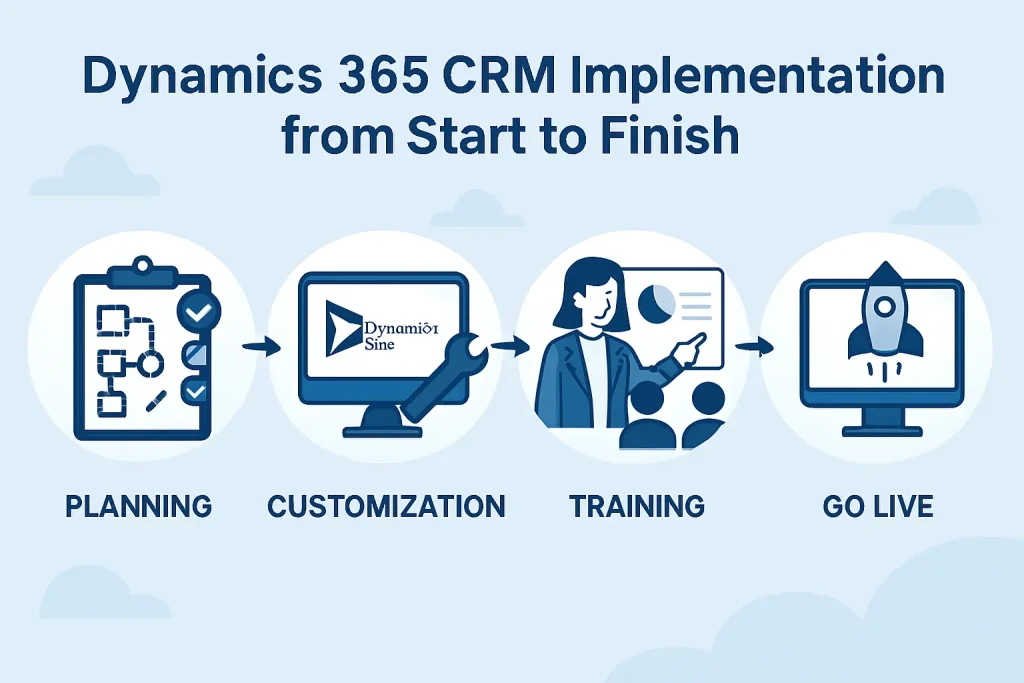Your CRM shouldn’t go down when you need it most. Yet that’s exactly what happens when critical sales calls, customer inquiries, and deal closures depend on servers sitting in your office basement or data center.
The reality is stark: while you’re busy dealing with maintenance windows, storage limits, and security updates, your team is missing opportunities.
Dynamics 365 CRM on-premise to cloud migration removes these friction points entirely.
This comprehensive guide will walk you through the strategic considerations, implementation roadmap, and post-migration benefits that transform how your organization manages customer relationships and drives revenue growth.
Key Takeaways
Follow these steps for Dynamics 365 CRM on-premise to cloud migration:
- Step #1: Assess and plan: Audit your current CRM setup to define migration goals, timelines, and resources.
- Step #2: Choose migration approach: Pick between lift-and-shift, phased, or reimplementation based on system complexity and priorities.
- Step #3: Design and map: Build the target Dynamics 365 environment with proper data mapping, security, and integrations.
- Step #4: Migrate data: Move data in controlled batches using SSIS, Azure Data Factory, and Dataverse APIs.
- Step #5: Rewire integrations: Modernize ERP, IoT, and SharePoint connections with Azure-native tools.
- Step #6: Test and validate: Verify functionality, security, and data accuracy before go-live.
- Step #7: Go-live and support: Monitor performance, resolve issues, and train users post-migration.
Why Businesses are Moving Dynamics CRM from On-Premise to Cloud

The cloud migration trend has reached a tipping point.
In 2025, the global public cloud market is projected to reach $980.30 billion in revenue, with Software as a Service (SaaS) expected to be the dominant segment. Organizations are evidently discovering tangible benefits of moving from on-premise to cloud that directly impact their bottom line and operational efficiency.
Some of these include:
Predictable Budgets
Cloud-based Dynamics 365 eliminates surprise IT costs tied to server breakdowns or hardware refreshes.
Companies work with a stable subscription model, giving finance leaders confidence to invest freed-up funds into customer growth, product innovation, or expansion.
Uninterrupted CRM Access
The ‘work from anywhere’ reality has changed business expectations.
Your sales teams need access to customer data during client visits, support agents must resolve issues from home, and managers require real-time dashboard access on mobile devices.
Built-in Security and Compliance
Cloud deployment brings Microsoft’s enterprise-grade protections—24/7 monitoring, advanced threat detection, and compliance certifications that are expensive to achieve in-house.
For industries like finance, healthcare, and government, this assurance makes cloud the safer choice.
On-Premise to Cloud Migration Strategy for Dynamics 365 CRM

Here’s how our team at Aegis Softtech approaches Dynamics 365 CRM on-premise to cloud migration.
Step #1: Assess and Plan
Every successful CRM migration begins with a comprehensive discovery of your current environment and business requirements. Your foundation then determines timeline, approach, and resource allocation for the entire project.
We begin with a technical environment audit, which covers:
- Customization inventory: Document all plugins, JavaScript customizations, and workflow modifications that affect migration complexity.
- Integration mapping: Identify SSIS packages, custom data flows, and connections to external systems like ERP platforms.
- Data architecture review: Analyze record volumes, entity relationships, and custom field configurations.
- Security configuration analysis: Review user roles, permissions, and access patterns that need replication in the cloud.
Business process evaluation runs parallel to technical discovery, ensuring migration supports operational improvements rather than simply replicating existing limitations. Understanding current system usage patterns helps identify optimization opportunities that cloud capabilities can unlock.
Step #2: Choose the Right Migration Approach
Your ideal Dynamics 365 CRM on-premise to cloud migration strategy depends on system complexity, available timeline, and organizational change tolerance. Each approach offers different advantages and resource requirements.
Here are the migration options we test for alignment:
- Lift-and-shift migration: Moves existing setup with minimal changes, fastest path to cloud benefits, typically 2-4 months for standard configurations.
- Phased migration: Spreads transition across multiple stages, reduces risk while allowing gradual adaptation, 6-12 months for complex environments.
- Reimplementation approach: Rebuilds processes using modern cloud capabilities, eliminates technical debt, 6-18 months with highest long-term value.
The selection criteria should align with business priorities, available resources, and tolerance for operational disruption during transition.
Step #3: Design the Target Solution and Map Your Environment
Once the assessment phase is complete, the next step is designing your target cloud setup in Dynamics 365. This stage defines how your existing system translates into a scalable cloud structure.
We focus on:
- Entity schema mapping: Aligning on-premise data structures with Dataverse entities for accurate relationships and field mapping
- Security role replication: Recreating existing access controls, permissions, and hierarchies within Dynamics 365
- Integration planning: Preparing for Azure service connections, Power Automate flows, and Microsoft Teams collaboration features
- Workflow modernization: Redesigning legacy on-premise workflows using Power Platform capabilities to enhance automation and scalability
Step #4: Execute Data Migration in Controlled Phases
After design approval, we move to data migration, carefully executed to maintain business continuity and data accuracy.
Our approach includes:
- Batch migration strategy: Starting with non-critical datasets to validate mappings and minimize downtime
- Hybrid technology use: Combining SSIS with KingswaySoft adapters, Azure Data Factory, and Dataverse APIs for different data volumes and complexities
- Data verification checks: Conducting record-level validations and reconciliation reports after each batch
- Incremental sync setup: Configuring continuous data updates until the final cutover to ensure no information loss
Step #5: Reconfigure and Optimize Integrations
Our experts re-engineer existing integrations to align with the new Dynamics 365 cloud environment while improving performance and maintenance.
We handle:
- Integration inventory: Reviewing current ERP, IoT, and SharePoint connections to determine compatibility
- Middleware modernization: Replacing outdated connectors with Azure Logic Apps, Event Hub, or Service Bus
- Authentication updates: Configuring secure credentials and token-based access for all endpoints
- End-to-end validation: Testing communication flows and data synchronization between all systems
Step #6: Test, Validate, and Benchmark Performance
Before go-live, extensive testing confirms the stability and accuracy of your migrated environment.
We perform:
- Functional testing: Validating workflows, automations, and business logic across all modules
- Security assessments: Ensuring data access, encryption, and compliance policies are correctly applied
- Performance benchmarking: Measuring response times, throughput, and load capacity
- Data validation reports: Using Power BI dashboards and audit logs to verify accuracy and consistency
Step #7: Go-Live and Provide Post-Migration Support
The go-live phase marks the transition to active cloud operations, supported by continuous monitoring and user enablement.
We support clients through:
- Hyper care monitoring: Tracking performance metrics, issue logs, and data consistency post-deployment
- Gap resolution: Addressing any residual data discrepancies or workflow errors
- User enablement: Training teams to utilize new features like AI-driven lead scoring, Copilot assistance, and Power Apps dashboards
- Post-migration optimization: Conducting regular health checks and introducing best practices for sustained performance
Dynamics CRM Data Migration Considerations
Dynamics CRM data migration success requires careful planning around data volume, relationship integrity, and business continuity that keep operations running smoothly throughout the transition.
Volume planning becomes critical when handling millions of records across accounts, contacts, opportunities, and custom entities. Modern tools like Azure Data Factory can manage bulk transfers efficiently, but proper sequencing prevents bottlenecks that could extend migration timelines unnecessarily.
Essential considerations for successful data transfer include:
- Schema mapping: Ensure field compatibility and data integrity between source and target systems without losing critical information.
- Relationship preservation: Maintain lookup connections and hierarchical structures across all entities to prevent broken workflows.
- Data transformation: Handle format changes, picklist updates, and field mapping requirements that align with cloud standards.
- Quality validation: Use automated testing and validation dashboards to verify accuracy throughout the CRM data migration process.
Testing and validation phases protect against productivity disruptions while ensuring business continuity during the transition period. This investment in quality control pays dividends by preventing post-migration data issues that could impact customer relationships.
Key Benefits of Dynamics 365 CRM On-Premise to Cloud Migration
Migration to the cloud delivers measurable advantages across multiple business dimensions. Here’s what you can expect when moving Dynamics CRM to the cloud environment.
Scalability and Flexibility
Cloud infrastructure adapts to your business growth without the traditional planning, procurement, and installation cycles that slow expansion. When you need to add 50 new sales reps during a rapid growth phase, the system accommodates them immediately without hardware constraints.
Look at some real growth scenarios:
- Seasonal scaling: Retail organizations can scale up processing power during holiday rushes, then scale back during slower periods, paying only for actual usage.
- Geographic expansion: Opening new offices doesn’t require shipping servers or hiring local IT staff.
- User growth: Manufacturing clients have seen their user base grow by 60% within a year after migration, without a single day of disruption.
- Storage expansion: Customer databases grow automatically without capacity planning or storage upgrade projects.
Integration With Microsoft 365 and Power Platform
The cloud creates workflow possibilities that on-premise systems simply cannot match through native connectivity across the entire Microsoft ecosystem.
Moreover, Power Automate creates automated workflows for your routine processes. When deals reach specific stages, the system triggers personalized follow-up emails, updates related records, and notifies team members.
Integration wins may include:
- Healthcare providers: Implemented automated patient follow-up workflows, resulting in higher appointment attendance rates.
- Manufacturing companies: Connect IoT sensor data directly into CRM workflows for predictive maintenance alerts.
- Financial services firms: Automate compliance reporting by connecting CRM data with regulatory systems.
- Retail organizations: Sync inventory levels with customer opportunity records for accurate sales forecasting.
Better Performance and Faster Updates
Microsoft’s global infrastructure delivers consistent performance improvements that most organizations notice immediately. The distributed nature of cloud computing eliminates many bottlenecks that plague on-premise installations.
Page loads become faster when switching between accounts and opportunities, report generation speeds up even with large datasets, and mobile app performance remains responsive regardless of location.
What’s more, continuous innovation arrives without disruption.
AI-powered CRM sales forecasting capabilities appear automatically, enhanced mobile features roll out seamlessly, and advanced analytics tools activate without requiring downtime.
Enhanced Security and Compliance
Microsoft invests billions in cloud security infrastructure that most organizations could never afford to build internally. This includes advanced threat detection, automated patching, and compliance frameworks for regulations like GDPR, HIPAA, and SOX.
Here are some notable security advantages:
- Financial services clients: Access faster compliance checks after migration, saving weeks in regulatory reporting cycles and fewer reported audit exceptions.
- Healthcare organizations: Meet HIPAA requirements with built-in compliance templates and automated audit trails.
- Government agencies: Manage data residency controls to ensure sensitive information stays in appropriate geographic regions.
- Manufacturing companies: Protect intellectual property with enterprise-grade encryption that would cost millions to implement independently.
Improved IT Productivity
Your technical team stops fighting infrastructure fires and starts driving business value. This shift represents one of the most significant organizational benefits of moving from on-premise to cloud.
Time previously spent on server maintenance gets redirected toward initiatives that support business growth, such as:
- Custom app development: Using Power Platform to solve specific business challenges that drive revenue
- Advanced analytics projects: Revealing actionable business insights from CRM data that improve decision-making
- Integration with business-critical systems: Connecting ERP platforms and industry-specific tools for seamless operations
- User training initiatives: Improving adoption and productivity across departments through better system utilization
Consolidated Administration
Managing everything from a single cloud console reduces administrative overhead while improving security and compliance consistency.
User management covers CRM access, email accounts, and collaboration tools from one central location, reducing configuration errors. Security policies apply consistently across all Microsoft 365 services, while data backup strategies cover CRM, SharePoint, and Teams automatically.
The administrative efficiency gains compound over time, freeing resources for more strategic activities while reducing the risk of security gaps or compliance violations.
Common Challenges When Migrating From On-Premise to Cloud

Migration projects encounter predictable obstacles that can cause delays and budget overruns if not addressed proactively.
Let’s look at some of these challenges.
Legacy Customizations and Unsupported Workflows
On-premise Dynamics CRM implementations accumulate customizations over time that may not function in cloud environments. These customizations create technical debt requiring modernization during migration.
JavaScript web resources might use deprecated APIs, custom plugins could target outdated SDK versions, and workflows may rely on on-premise functionality that cloud security restrictions prevent.
Common modernization requirements include:
- Code modernization: Refactor JavaScript to use supported Web API calls compatible with cloud security
- Plugin updates: Upgrade custom code to current Dynamics 365 SDK standards and best practices
- Workflow replacement: Replace legacy workflows with Power Automate flows, offering better reliability
- Integration redesign: Convert direct database access to secure API-based connections
User Resistance or Training Gaps
Teams comfortable with familiar on-premise interfaces often experience productivity concerns during cloud transitions. This resistance particularly affects power users who have developed system shortcuts and workarounds over time.
Change management becomes as critical as technical execution for ensuring migration success. Users need to understand both interface changes and the business benefits of moving from on-premise to cloud, that justify the learning curve.
Effective strategies include:
- Role-specific training: Focus on daily tasks and common procedures rather than comprehensive feature overviews
- Quick reference materials: Provide guides for frequent actions that maintain productivity during transition
- Champion identification: Leverage early adopters to demonstrate benefits and share best practices
- Gradual rollout: Introduce new capabilities progressively to prevent overwhelming users with simultaneous changes
Security Misconfigurations or Data Loss Risks
Cloud security models require different approaches than on-premise thinking. Configuration mistakes can create vulnerabilities or compliance gaps that put sensitive data at risk without proper planning and implementation oversight.
Organizations often assume current security models transfer directly to cloud environments, creating exposure through inappropriate permission settings or inadequate monitoring configurations that leave data vulnerable.
Making the Move: Migration From On-Premise to Cloud
Your current on-premise system likely requires more maintenance resources while delivering less business value than cloud alternatives. Every quarter your organization delays Dynamics CRM data migration represents lost opportunities while competitors leverage cloud capabilities that your current system cannot match.
Aegis Softtech’s Microsoft Dynamics CRM Services bring proven expertise across industries and technical environments, ensuring migrations deliver business value.
FAQs
1. How to migrate from on-premise to cloud?
A successful Dynamics 365 CRM on-premise to cloud migration starts with planning. Businesses usually define a strategy, prepare for CRM data migration, and test everything before going live. Using Microsoft tools or working with a partner like Aegis Softtech helps reduce risks and ensures the migration is smooth.
2. Can Dynamics 365 be on-premise?
Yes, Dynamics 365 can still run on-premise. However, many companies are now focusing on migration from on-premise to cloud because the cloud version offers better scalability, easier updates, and lower maintenance costs.
3. Is Dynamics 365 CRM cloud-based?
Yes, Dynamics 365 CRM is primarily cloud-based. While the on-premise version exists, most businesses prefer the cloud because it delivers continuous updates, strong security, and flexibility for remote teams.
4. What is the difference between CRM online and on-premise?
CRM online refers to the cloud deployment, where Microsoft manages updates, infrastructure, and security. In contrast, the on-premise version requires the business to handle servers, upgrades, and backups. The shift to CRM online highlights the benefits of on-prem to cloud migration, such as predictable costs, faster innovation, and improved accessibility.



